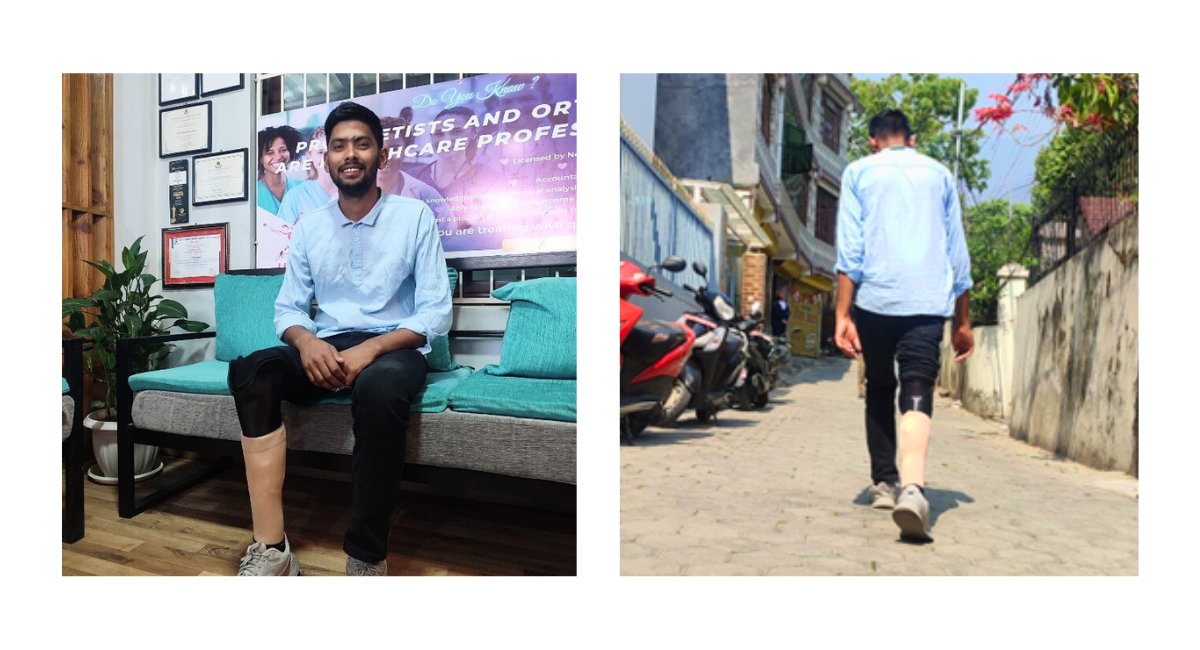Aakash’s Journey with Transtibial Prosthesis
Background and Context
Aakash, a 26-year-old youth from Jhimruk in Pyuthan, a remote hill district of Nepal, embodies resilience in the face of adversity. In July 2021, during Nepal’s national COVID-19 lockdown, Aakash suffered a life-altering accident. While helping his uncle transport construction materials for a local community water project using a farm tractor - a common livelihood strategy in rural Nepal - he was involved in a devastating crash. The vehicle skidded off a narrow, muddy mountain road and plummeted 400 meters down a hillside. Aakash sustained severe injuries to his ankle, spine, and head. Despite immediate first aid at a local health post and subsequent referral, he endured a gruelling 32-hour journey to Kathmandu, exacerbated by monsoon-induced landslides.
Following hospitalisation and delayed surgical procedures due to COVID-19 protocols, Aakash underwent a below-knee amputation on his right leg. His family incurred treatment costs exceeding NPR 1.8 million (approx. GBP 11,000), relying on public charity and high-interest loans. Like many in Nepal, they were confronted with a health system challenged by limited-service coverage, high out-of-pocket expenses, and geographic inaccessibility.
Initial Support and Rehabilitation
Aakash initially received his first prosthetic limb through a Charity. Provided via conventional fabrication methods, this device allowed him to regain basic mobility after an extended period of immobility and self-isolation.
Aakash’s initial dream was to return to his village and establish a local computer training institute. However, following his injury, his focus shifted toward public service preparation - a pragmatic decision influenced by family advice and the need for stable, accessible employment options. He continued his university education while commuting daily, now dependent on consistent and reliable assistive technology to avoid disruption in exams and lectures.
AT2030 and the Promise of Digital Prosthetics
In 2024, two years after receiving his first prosthesis, Aakash was identified as a potential beneficiary of the AT2030 programme, supported by UK International Development and UNICEF Nepal, and implemented by the Global Disability Innovation (GDI) Hub in partnership with Center for Disabled Children Assistance (CDCA) (Enabling Fridays Consortium). The programme aimed to increase access to high-quality assistive technology through digital innovations in prosthetic provision, using 3D printing and data-driven design.
Aakash was fitted with a second transtibial prosthetic leg manufactured via a digital prosthetic workflow. The device, developed through scanning, computer-aided design, and 3D printing technologies, represents a scalable solution for addressing the global gap in assistive technology - where only an estimated 10% of those in need have access to appropriate devices (WHO, 2022).
Impact on Mobility, Independence, and Aspirations
Since receiving the new device, Aakash reports wearing the prosthesis for up to 10 hours daily, six days a week. “Now, I can do my tasks on my own,” he stated. The prosthesis has allowed him to perform routine activities such as grocery shopping independently and has reduced his “reliance on family members.” Importantly, it has enhanced his psychosocial wellbeing and restored his confidence.
During a follow-up clinic in March 2025, organised by GDI Hub and Limb Care Nepal, Aakash benefited from maintenance services, including liner adjustments and repairs to a loosened foot component. While willing to contribute financially for future maintenance, Aakash acknowledges the cost would impose a significant burden. This underscores the broader challenge of long-term sustainability in assistive technology access, particularly for low-income users.
Looking Ahead: Steps Toward a Brighter Future
As the eldest child in a farming family dependent on subsistence agriculture, Aakash carries both hope and responsibility. His two younger sisters remain under the care of ageing parents in the village, while he continues his studies and competitive exam preparation in Kathmandu. Although his dream of establishing a computer training centre in Bagdula, Pyuthan, remains deferred, he views education as a crucial stepping stone toward eventual community reinvestment.
Through the support of the AT2030 programme, Aakash is not only able to walk - he is also able to move forward in life. His story exemplifies how digital innovations in prosthetics can provide not just mobility, but also dignity, independence, and opportunity.
Acknowledgements
This impact was made possible through the collaborative efforts of UK International Development’s AT2030 programme, GDI Hub, UNICEF Nepal, CDCA, Limb Care Nepal and Epidemiology and Disease Control Division – Leprosy Control and Disability Management Section (EDCD-LCDMS) of the Ministry of Health and Population Nepal. Special thanks to Aakash for sharing his story and to the frontline prosthetists and clinical teams supporting inclusive mobility solutions in Nepal.
